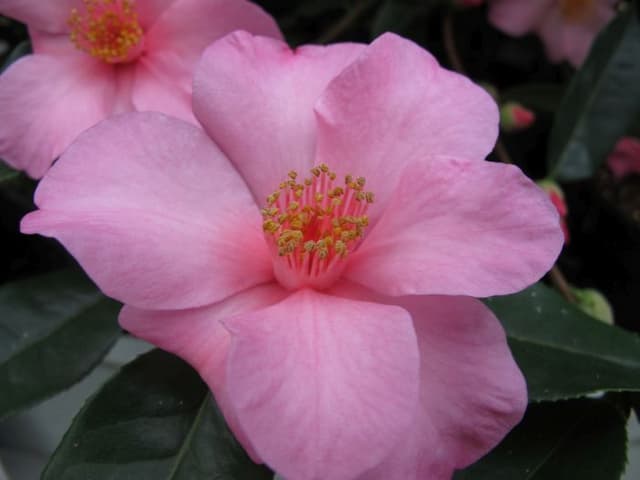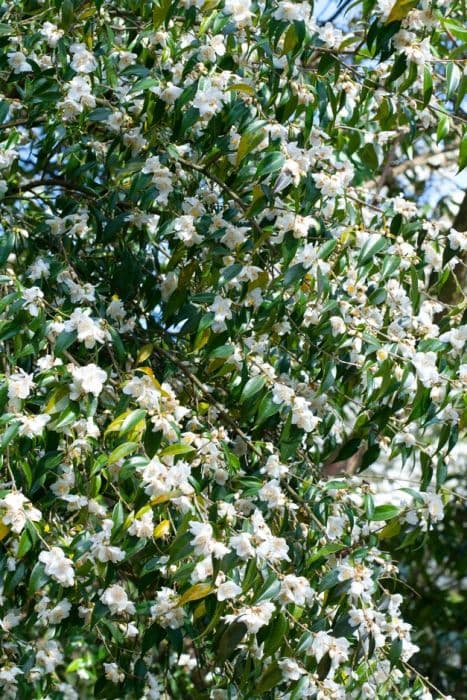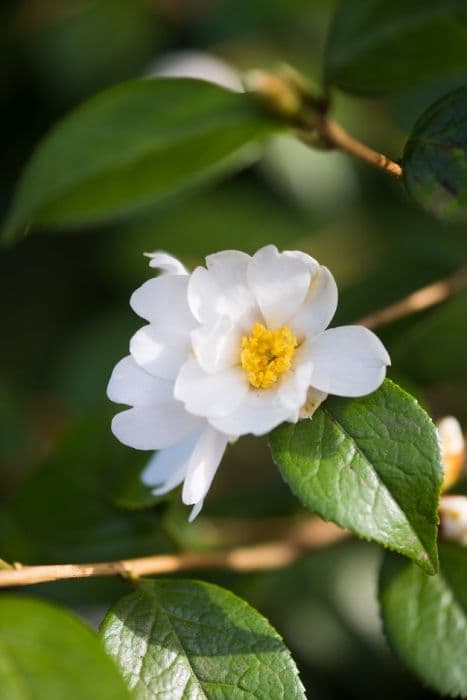Camellia Camellia × williamsii 'Señorita'

ABOUT
The Camellia 'Señorita' is an ornamental plant known for its beautiful flowers and glossy, dark green foliage. The leaves are typically oval-shaped with a slightly serrated edge, providing a lush backdrop for the stunning blooms. The flowers themselves are the true highlight, displaying an array of pink shades with a mesmerizing appeal. Each bloom is comprised of numerous layered petals that create a dense and ruffled appearance, giving the flower a full and extravagant look. The hues can vary from a soft, pale pink to a more vibrant, deep pink, often with a delicate gradation of color radiating from the center outwards. The flowers are visually striking and can serve as a focal point in any garden setting. The overall impression of the Camellia 'Señorita' is one of elegance and classic charm, offering year-round interest with its evergreen foliage and seasonal blossoms that captivate and delight the senses.
About this plant
 Names
NamesFamily
Theaceae
Synonyms
Williams' Camellia, Hybrid Camellia, Senorita Camellia
Common names
Camellia × williamsii 'Senorita'.
 Toxicity
ToxicityTo humans
The Williamsii camellia typically does not have significant toxicity to humans. Therefore, if ingested, it is not expected to cause serious poisoning or severe symptoms in most individuals. However, as with any non-food plant, consuming parts of the plant might cause mild gastrointestinal discomfort or an allergic reaction in sensitive individuals. It is generally advised to avoid eating ornamental plants due to the potential for irritation or mild stomach upset.
To pets
The Williamsii camellia is generally considered to be non-toxic to pets. Dogs and cats that ingest parts of this plant are not likely to experience significant symptoms of poisoning. While it is always a good practice to prevent pets from eating non-food plants, ingestion of this camellia typically does not lead to serious illness. As with humans, the most likely consequence of a pet ingesting the plant would be mild gastrointestinal upset.
 Characteristics
CharacteristicsLife cycle
Perennials
Foliage type
Evergreen
Color of leaves
Green
Flower color
Pink
Height
4-6 feet (1.2-1.8 meters)
Spread
4-6 feet (1.2-1.8 meters)
Plant type
Shrub
Hardiness zones
7
Native area
Asia
Benefits
 General Benefits
General Benefits- Ornamental Value: Camellia × williamsii 'Señorita' offers aesthetic appeal with its beautiful flowers, enhancing the visual beauty of gardens and landscapes.
- Year-Round Interest: This plant provides interest throughout the year with its evergreen foliage and winter to spring blossoming period.
- Suitable for Shaded Areas: It thrives in partial shade, making it ideal for planting under tree canopies or in shadowed parts of a garden.
- Low Maintenance: Requires minimal pruning and can maintain its shape and size with little care, making it suitable for low-maintenance gardens.
- Drought Tolerance: Once established, it's fairly tolerant to dry conditions, requiring less watering compared to other garden plants.
- Wildlife Attraction: The flowers can attract pollinators such as bees, and sometimes hummingbirds, which can aid in the pollination of other plants.
- Versatility: Can be used in various landscape designs, including as a specimen plant, in mass plantings, or as part of a mixed border.
- Long Blooming Period: Its flowering season extends over a long period, providing color and interest when many other plants are not in bloom.
- Soil Adaptability: Tolerates a wide range of soil conditions, although it prefers well-drained, acidic soil.
- Privacy Screen: With its dense growth habit, it can serve as an effective privacy screen or windbreak when planted in a row or hedge.
 Medical Properties
Medical PropertiesThis plant is not used for medical purposes.
 Air-purifying Qualities
Air-purifying QualitiesThis plant is not specifically known for air purifying qualities.
 Other Uses
Other Uses- Composting Material: Fallen camellia leaves and spent blooms can add organic matter to compost piles, enriching future soil.
- Artistic Inspiration: The camellia's vibrant flowers and glossy leaves often serve as subjects for botanical artists and photographers.
- Educational Tool: Camellias, being part of the tea family, can be used in educational settings to teach about plant biology and taxonomy.
- Floral Arrangements: Camellia flowers can be floated in bowls of water for simple yet elegant centerpieces.
- Wedding Decor: Due to their beauty, camellia blossoms can be incorporated into wedding ceremonies as part of bouquets or venue decoration.
- Craft Projects: The sturdy leaves and flowers of the camellia can be used in DIY and craft projects, like creating bookmarks or pressed flower art.
- Cultural Symbolism: In some cultures, camellias are a symbol of love and devotion, and are thus used in various cultural ceremonies and artworks.
- Culinary Garnish: Although not typically eaten, camellia flowers can be used as non-toxic garnishes to add visual appeal to dishes.
- Dye Production: The petals of the camellia flower can be used to produce natural dyes for fabric or paper.
- Anime/Manga Motif: The beauty of camellias often inspires their use as a motif in Japanese anime and manga to add symbolism or decorate scenes.
Interesting Facts
 Feng Shui
Feng ShuiCamellia is known in Feng Shui for attracting positive energy and is often associated with love, affection, and admiration, given its beautiful blossoms. To use Camellia in Feng Shui, place it in the southwest area of your garden, home, or living room to enhance love and romantic relationships, or in the south area to improve recognition and honor.
 Zodiac Sign Compitability
Zodiac Sign CompitabilityCamellia is not used in astrology practice.
 Plant Symbolism
Plant Symbolism- Admiration: Camellias are often associated with deep admiration for someone's qualities or talent.
- Perfection: As a plant with beautiful blooms that seem almost perfect, Camellias can symbolize the ideal or perfection.
- Love: Gifting Camellias can express love or romantic interest, particularly red varieties which are associated with passionate love.
- Affection: Beyond romantic love, Camellias may also signify affection or deep friendship.
- Longevity: Since Camellias are evergreen and can live for many years, they symbolize longevity or the wish for a long and healthy life.
- Gratitude: In some cultures, Camellias represent gratitude and are given as gifts to show appreciation.
 Water
WaterThe Williamsii Camellia should be watered to keep the soil consistently moist but not waterlogged. Typically, this means watering the plant once a week with about 1 to 1.5 gallons of water, depending on the size of the plant and the weather conditions. During the growing season in spring and summer, you may need to water more frequently, especially if the weather is dry or windy. In winter, reduce watering as the plant's growth slows down. Ensure good drainage to prevent root rot, and use rainwater if possible, as camellias can be sensitive to high levels of lime often found in tap water.
 Light
LightWilliamsii Camellias prefer partial shade with some morning sun or dappled sunlight throughout the day. They should be protected from the intense afternoon sun to prevent leaf scorch. A spot that receives filtered light under the canopy of tall trees or on the north or east side of a building is often ideal for these plants, providing them with the best balance of light exposure.
 Temperature
TemperatureThe Williamsii Camellia thrives in temperatures between 40 and 85 degrees Fahrenheit. They can tolerate a minimum temperature of around 10 degrees Fahrenheit for short periods, but they are not suited to extreme cold and should be protected from frost. Ideal growing conditions are achieved when the temperature does not fluctuate dramatically and stays within a moderate range.
 Pruning
PruningWilliamsii Camellias should be pruned to maintain size and shape, as well as to encourage bushier growth and more flowers. The best time to prune is just after the blooming period, in the spring, before the new growth starts. Pruning too late in the season can remove buds set for the next year's blooms. Thin out crowded branches and remove any dead or diseased wood.
 Cleaning
CleaningAs needed
 Soil
SoilThe best soil mix for the Williamsii Camellia 'Señorita' is well-draining, rich in organic matter, and slightly acidic with a pH of 5.5 to 6.5. A mixture of equal parts compost, pine bark, and perlite or sand will provide the right texture and fertility for optimal growth.
 Repotting
RepottingWilliamsii Camellia 'Señorita' should be repotted every 2-3 years or when it outgrows its current pot. Repotting in late winter or early spring is ideal to not disrupt the blooming cycle.
 Humidity & Misting
Humidity & MistingWilliamsii Camellia 'Señorita' thrives best in moderate to high humidity levels, ideally between 40-60%. Avoid placing the plant in dry environments as this can lead to bud drop.
 Suitable locations
Suitable locationsIndoor
Ensure bright, indirect light and high humidity for indoor Williamsii Camellia.
Outdoor
Place in dappled shade with moist, well-draining soil for outdoor Williamsii Camellia.
Hardiness zone
7-9 USDA
 Life cycle
Life cycleCamellia × williamsii 'Señorita' begins its life cycle from seeds or cuttings, with seeds requiring stratification to break dormancy. Once germinated or rooted, the williamsii camellia starts as a seedling or young plant, with its initial growth characterized by the development of a root system and a few sets of leaves. As it enters the vegetative stage, the plant grows more foliage and branches, establishing a shrub form; this stage can take several years before the plant reaches maturity. Upon maturity, the camellia blooms annually, typically in late winter to early spring, producing large, showy flowers that are a distinguishing feature of the hybrid. After the blooming period, if pollination occurs, the plant may produce fruit in the form of a dry capsule containing seeds that can continue the cycle. Outside of its reproductive cycle, the camellia is an evergreen shrub that continues to grow and thicken, undergoing cycles of foliage renewal and flowering year after year.
 Propogation
PropogationPropogation time
Spring-Early Summer
The Camellia × williamsii 'Señorita', commonly known as Japonica or simply Camellia, can be successfully propagated by semi-hardwood cuttings. This popular method involves taking cuttings from the current year's growth in late summer to early autumn when the stems have partially matured but are not yet fully hardened. A cutting of about 4 to 6 inches (approximately 10 to 15 centimeters) is snipped just below a leaf node, and the lower leaves are removed to expose a clean stem. The cutting's base is then dipped in rooting hormone powder to enhance root development and planted in a pot with well-draining soil, such as a mix of peat and perlite. The pot is kept under a humidity dome or plastic cover to maintain moisture and placed in indirect light. Cuttings typically root in several weeks, after which they can be transferred into individual pots to grow on before eventual planting out.









